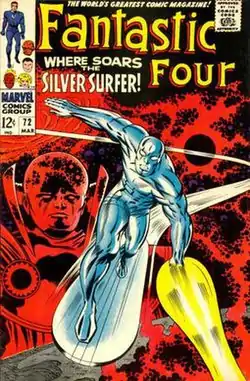
The Kirby Krackle (also known as Kirby Dots)[1] is an artistic convention in superhero and science fiction comic books and similar illustrations, in which a field of black is used to represent negative space around unspecified kinds of energy.[2][3] It is typically used in illustrations of explosions, smoke, blasts from ray guns, "cosmic" energy, and outer space phenomena.[4][5]
History
The effect is named after its creator, comic artist Jack Kirby.[3] While the Kirby Krackle in its mature form first appeared in Kirby's work during 1965–1966 (in Fantastic Four and Thor),[2] comics historian Harry Mendryk of the Jack Kirby Museum & Research Center has traced the earliest version of the stylistic device as far back as 1940 to Jack Kirby and Joe Simon's Blue Bolt #5. As Joe Simon was the inker on that comic, he may have been partially responsible for look of the proto-Kirby Krackle. Examples of a transitional form of the Kirby Krackle appear in two of Kirby's stories from the late 1950s: The Man Who Collected Planets from 1957 (pencils and inks by Kirby) and The Negative Man from 1959 (inks attributed to Marvin Stein).[3] The effects were used during the transformation sequences in the Ben 10 franchise.
Kirby Krackle is incorporated into the design of the Guardians of the Galaxy – Mission: Breakout! attraction in Avengers Campus at Disney California Adventure.[6] and Moon Girl and Devil Dinosaur.[7][8]
Analysis
Philosophy professor and author Jeffrey J. Kripal wrote:
For Kirby, the human body is a manifestation or crystallization of finally inexplicable energies—a superbody. [...] What Mesmer called animal magnetism, Reichenbach knew as the blue od, and Reich saw as a radiating blue cosmic orgone becomes in Jack Kirby a trademark energetics signaled by "burst lines" and a unique energy field of black, blobby dots that has come to be affectionately known as the "Kirby Krackle" [...]. The final result was a vision of the human being as a body of frozen energy that, like an atomic bomb, could be released with stunning effects, for good or for evil. These metaphysical energies, I want to suggest, constitute the secret Source of Kirby's art.[9]
References
- ↑ Crowder, Craig (2010). "Kirby, Jack". In Booker, M. Keith (ed.). Encyclopedia of Comic Books and Graphic Novels. Santa Barbara, CA: ABC-CLIO. p. 353.
- 1 2 Foley, Shane (November 2001). "Kracklin' Kirby: Tracing the advent of Kirby Krackle". Jack Kirby Collector. No. 33. Archived from the original on November 30, 2010. Retrieved April 30, 2015.
- 1 2 3 Mendryk, Harry (September 3, 2011). "Evolution of Kirby Krackle". Jack Kirby Museum: "Simon and Kirby". Archived from the original on June 4, 2012. Retrieved April 30, 2015.
- ↑ Duncan, Randy; Smith, Matthew J. (2010). Icons of the American Comic Book: From Captain America to Wonder Woman: From Captain America to Wonder Woman. Santa Barbara, CA: ABC-CLIO. p. 353. ISBN 9780313357473.
- ↑ Scientists Confirm Existence of 'Kirby Krackle'
- ↑ Carr, Kristen (June 2, 2021). "The biggest Easter egg at Disneyland's Avengers Campus is already on display". SFGate. San Francisco, CA USA. Retrieved June 2, 2021.
- ↑ "Interview: 'Marvel's Moon Girl and Devil Dinosaur' Cast and Creatives on Family, Lunella, and Bringing a Fresh Story to the Screen". Nerds and Beyond. February 6, 2023. Retrieved February 6, 2023.
- ↑ "The Colorful and Loving World of MOON GIRL AND DEVIL DINOSAUR". Nerdist. Retrieved February 6, 2023.
- ↑ Kripal, Jeffrey J. (2011). Mutants and Mystics: Science Fiction, Superhero Comics, and the Paranormal. Chicago, IL: University of Chicago Press. pp. 286–287. ISBN 9780226453859.